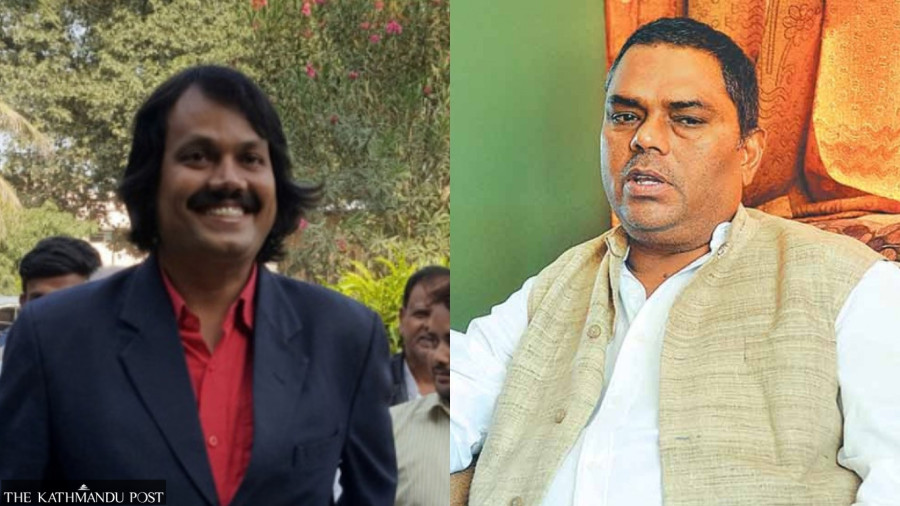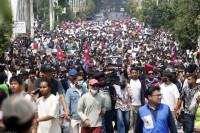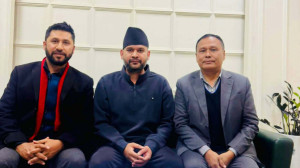Politics
Unpacking CK Raut’s win over Upendra Yadav
Raut’s personal touch with voters and Yadav’s overreliance on caste votes are key factors. JSP blames foreign hand.
Nishan Khatiwada
Janamat Party chair CK Raut’s victory in the federal polls from Saptari-2 heralded the emergence of a new force in Madhesh.
Raut secured a landslide victory in Saptari-2 over Janata Samajbadi Party (JSP) chair Upendra Yadav, with a resounding 18,063-vote margin.
With the counting of votes of the November 20 elections almost complete, the Janamat Party has already reached the three percent proportional votes threshold to become a national party. Yadav—who spearheaded the Madhesh movement in 2007 and 2008—was arguably the most powerful leader in Madhesh. He was also a major actor in national politics.
Yadav had won the 2017 polls from the same constituency—Saptari-2.
Raut’s spectacular win against such a powerful foe has surprised many: How did he do it?
Local observers said that after signing the 11-point agreement with the KP Oli-led government in March 2019 to join peaceful politics, Raut began working for the next round of elections. And he prioritised real social issues such as health, education and corruption over abstract political ones.
Speaking with the Post after the results of Saptari-2 were announced, Chandra Kishore, a Birgunj-based Madhesh observer, said consolidated votes from marginalised castes worked in CK Raut’s favour. “He has huge appeal among the marginalised communities and people from poor economic backgrounds. He started courting them and preparing for polls as soon as he quit his secessionist agenda,” he said.
Raut’s success is indicative of the failure of traditional caste-based politics, said Mamata Jha, district in-charge of the Janamat Party’s Saptari chapter. “People across caste groups voted for CK Raut, ignoring Upendra Yadav, who had long benefitted from caste politics,” she said.
Janamat Party General Secretary Chandan Singh said they started groundwork for elections soon after the party’s formation. “To garner public trust, we raised pressing issues of the farmers. Before polls, our active, educated and well-trained cadres and leaders knocked on people’s doors and listened to their concerns,” he said.
Janamat Party has thousands of engineers and the majority of its cadres are youths, party leaders claim.
Rajanikant Jha, an academic from Sarlahi, said Raut’s charismatic personality and his anti-corruption movement in Madhesh attracted youths tired of the rampant corruption and lack of accountability of local officials and politicians.
Raut stepped into Madhesh politics after the Madhesh uprising in 2006.
He then went to Japan for further studies before returning to Nepal and founding the Alliance for the Rights and Independence of Madhesh, an NGO. He then left for the US and upon his return in 2009, Raut travelled from Mechi to Mahakali with his friends, campaigning for an independent Madhesh. The campaign garnered considerable support from Madheshi youths.
The perception that he left a promising career in the US to lead a reform movement has won him a wide appeal especially among the Madheshi youths, say observers.
“His recent activism in favour of farmers’ rights and anti-corruption have been very popular. He has left an impression among the youth that his party can be the flag bearer of change in Madhesh,” said Jha, the academic.
According to him, youths in Nepal are attracted to radical ideas. In October 2021, Janamat Party cadres took Rajesh Kushwaha, the chief of the Department of Water Supply and Sewage Management, Janakpur hostage and paraded him on city streets. Kushwaha had supposedly failed to resolve the city’s drainage problem after heavy rainfalls had inundated local markets. “Such extreme actions get the youth’s attention. That’s why every political party mobilises youths,” said Jha.
Some election strategies of Raut and his Janamat Party resembled those of the Rabi Lamichhane-led Rastriya Swatantra Party. Raut and his supporters also used Nepali migrant workers abroad to exhort their family members back home to vote for the Janamat Party.
“The Nepalis who are abroad for work and study urged their family members in Nepal to vote for us. Our party has promised more jobs at home and to remove the need to go abroad for work. Educated youths, farmers, labourers and Dalits voted for us in droves,” added Singh, the Janamat Party General Secretary.
The public was fed up with Upendra Yadav and his self-centred politics, said Khusilal Mandal, another Saptari-based Madhesh observer.
“Raut cashed in on public frustration with traditional parties and their leaders,” said Mandal, adding, “Upendra Yadav’s appeal was already on the wane and his decision to forge an electoral alliance with the UML, which is seen as an anti-Madhesh party, was the last nail in the coffin.”
As the Janamat Party is certain to become a national party, Raut is already in negotiations with the ruling coalition, which is poised to form a new government.
On Thursday, Raut agreed to join the next government under Congress leadership. Congress leader Bimalendra Nidhi informed via social media that CK Raut, during his meeting with Prime Minister Sher Bahadur Deuba at Baluwatar, had agreed to join a Congress-led government.
Raut’s cadres call him an energetic leader who loves to listen to people’s problems.
“Unlike Upendra Yadav, CK sir visited every house in the constituency. He intently listened to everyone and promised to do something about their problems,” added Jha, the district in-charge. According to her, there was a remarkable presence of women in his election campaigns. “Raut focused on social issues such as health and education rather than playing dirty politics.”
Raut’s constituency, Saptari-2, comprises Mahadeva Rural Municipality, Tilathi Koiladi Rural Municipality, Rajbiraj Municipality, and Chhinnamasta Rural Municipality.
Janamat Party leaders had feared that traditional parties would use money to lure away voters during the silent period ahead of the elections, and so they were on alert against such activities. “The youths and women foiled any such attempts,” said Jha.
Leaders of the JSP, Upendra Yadav’s party, however, said there was no difference in the way Raut and Yadav conducted their respective election campaigns but that Raut benefited from swing votes of the ruling alliance.
Many of them are curious about why CK Raut contested polls, for the very first time in his life, from Saptari-2 where he would face a political heavyweight like Upendra Yadav? Couldn’t he have chosen ‘easier’ constituencies?
Dinesh Kumar Yadav, JSP’s Madhesh Province Committee chief secretary, suspects the involvement of both domestic and foreign powers. “If we study the election results, the candidate of the Congress-led alliance got just around 7,000 votes. This means alliance supporters deliberately voted for Raut instead of their candidate just to beat Yadav,” he said.
The rank and file of Upendra Yadav’s party believe Raut chose Saptari-2 at the instigation of a foreign power. Yadav is believed to have been in India’s bad books after he repeatedly blamed the southern neighbour of trying to engineer a split in his party. A year ago, he had even warned India not to intervene in Nepal's internal affairs.
Singh, the Janamat Party general secretary, rubbished the involvement of any foreign actor in Yadav’s loss. He said Raut won because of his signature strengths that Yadav lacked. Asked why Raut chose Saptari-2, he has an easy answer: “We all urged CK to contest from Saptari-2 as hails from the same constituency. It’s as simple as that.”




 9.12°C Kathmandu
9.12°C Kathmandu













%20(1).jpg&w=300&height=200)

